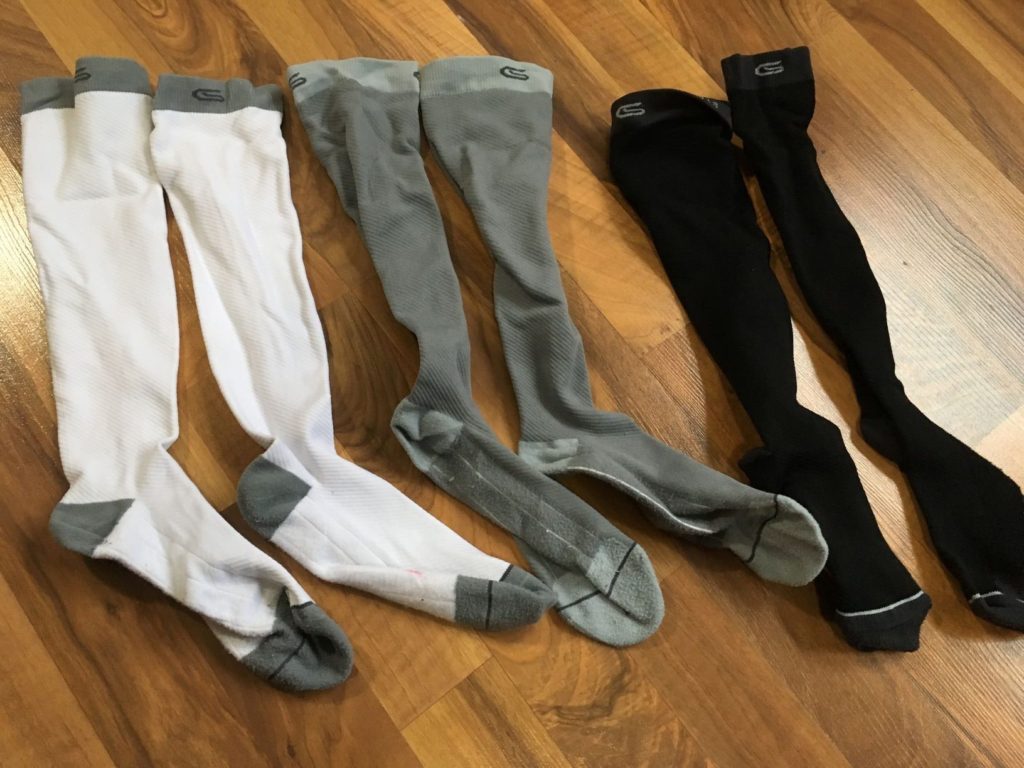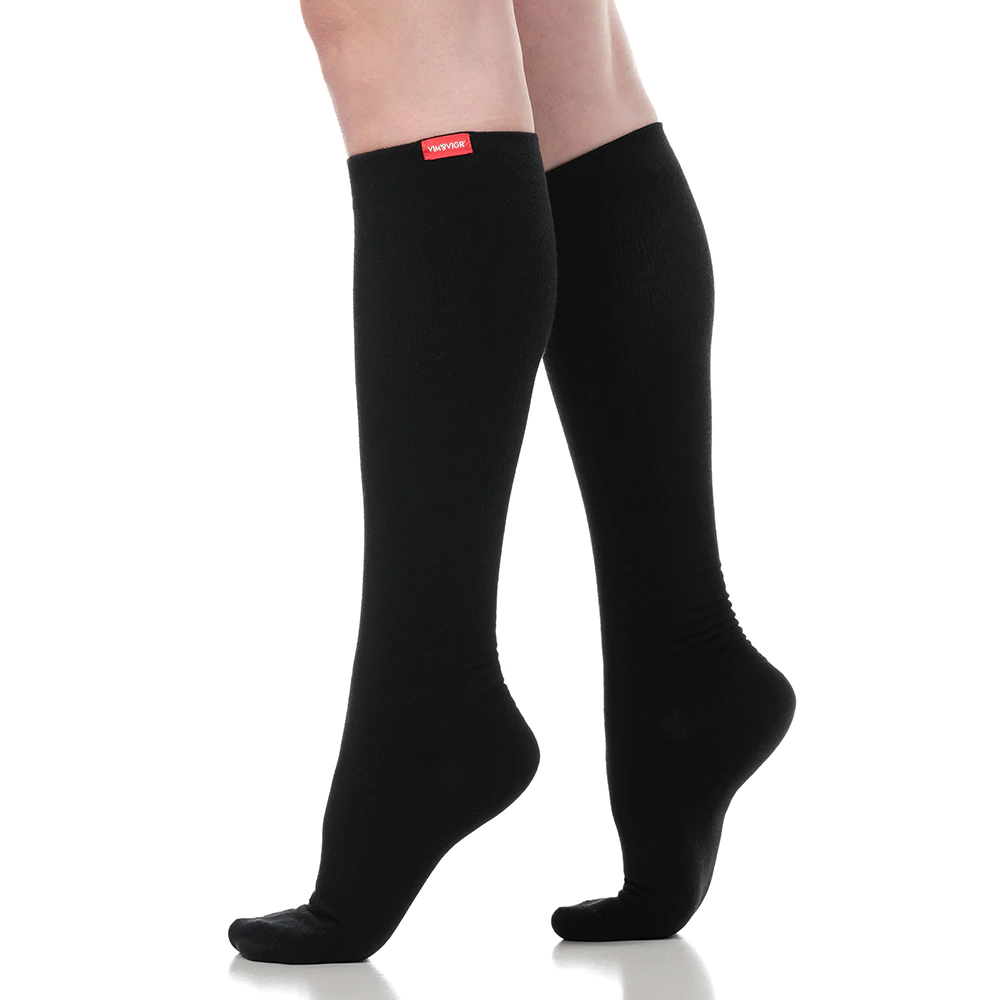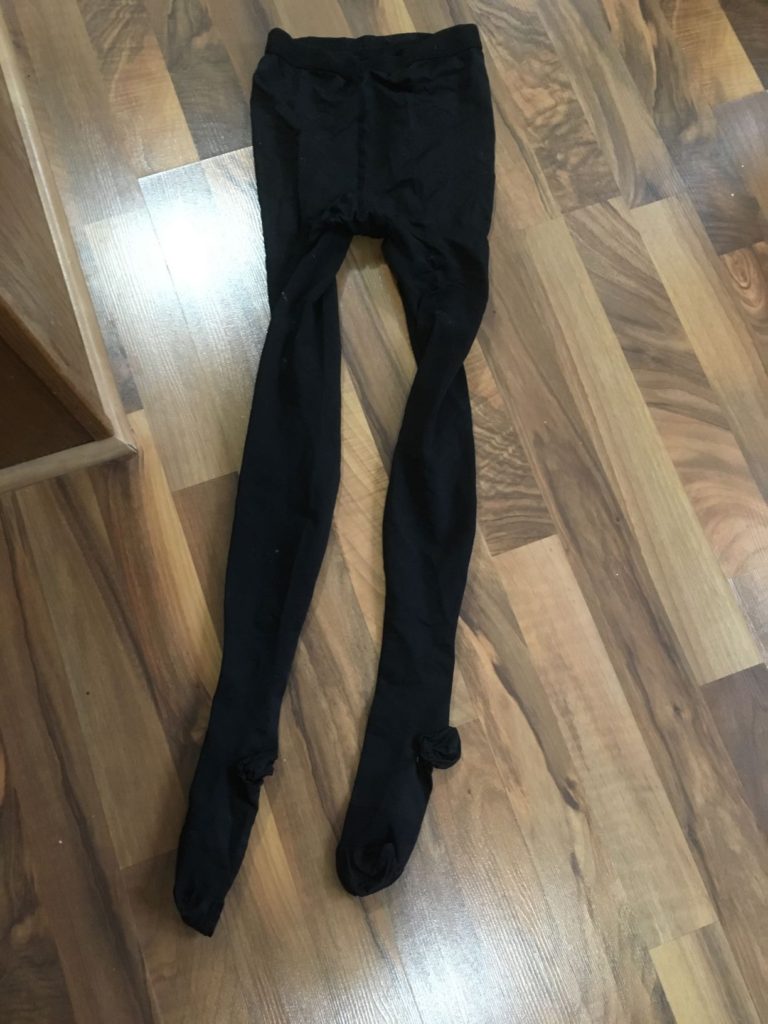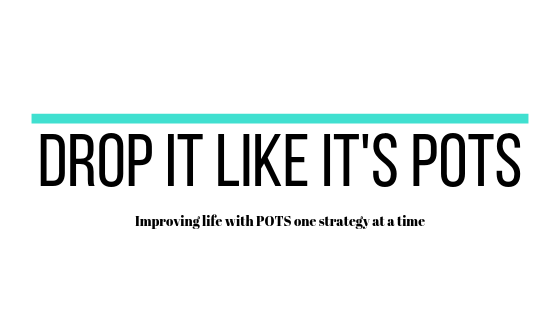Compression has not been a “slam dunk” POTS treatment for me. However, compression garments can be very life-changing for other people, so it is worth mentioning as a treatment for POTS. Different strategies can have very different outcomes for different people.
Disclaimer: Although my doctors have recommended compression garments to me, I am not necessarily a prime candidate given my brand of POTS. I explain more about this below. So, take my review for what it is worth.
How compression can help
Compression works by increasing venous return- pushing blood back upwards towards the heart. If blood is pooling in your extremities, it is just loitering there and not oxygenating the rest of your body. Compression addresses this issue. Practically speaking, compression may improve lightheadedness, fatigue, fainting, and brain fog. Some people may be able to tolerate more upright activities using compression.
There are a few scientific articles, such as this one, that discuss the benefits of compression. It also looks like there is a clinical trial that will wrap up next year studying the hemodynamic effects of compression in POTS. Part of this study will be to compare the efficacy of leg compression vs. abdominal compression, which would be interesting to see. The body of evidence in support of compression as a treatment of POTS is growing.
What kind is recommended
My neurologist recommends medical-grade, 40-60 mmHg, waist-high compression support hose for POTS. Some people opt for a less intense route and still reap benefits. It is worth trialing various types of compression and seeing what works best for you.
Where to buy them
Places I have purchased them from:
- A pair of knee-high socks from Amazon (linked below)
- A pair of waist-high support hose through Brightlife Direct
- A pair of knee-high socks from Vim and Vigr (specific product link below)
Michelle from the blog Living with Bob (Dysautonomia) has a lot of experience with compression and writes about where to purchase them in this post. She is in Australia, but she mentions US companies in the second half of the article. Michelle also has several other posts about compression that you can check out.
How to rock compression
Athletic-style compression tights can be worn like athletic leggings with sporty tops/tunics. Knee-high athletic compression socks can be worn with athletic shorts or under pants.
If you use medical grade waist-high compression hose, you have a few more options. You could wear them like pantyhose/tights with outfits. There are sheer and opaque compression hose options in nude, black, etc. You could hide them completely under pants. If you want to get creative there are even options of colorful and patterned compression hose. Check out Michelle’s instagram page for inspiration.
What I have tried

I have tried a 20-30 mmHg pair of compression socks from Amazon. There was no benefit to these except it reminded me of the knee-high white socks I used to wear all the time in middle school. $5 shorts and tank-top outfit from “Rave“- check, knee high white socks- check, brown leather sandals– check, and polish the look off with some excessive roll-on glitter from Art Stuff by Bath and Body Works- check.

I also tried these toe-less compression socks by Doc Miller. These compression socks are definitely more legit. I purchased them on Amazon after I saw another POTS patient recommend them. They have 30-40 mmHg compression. That is what the manufacturer claims, at least. I don’t know how regulated claims of compression strength are. However, I can attest that these have much more compression than Zensah calf sleeves and the other socks I tried from Amazon. I don’t think they provide any worthwhile benefit POTS-wise for me, but I still occasionally wear them because they make my leg muscles feel better.

I have a pair of nylon 30-40 mmHg compression socks from Vim and Vigr and like them. They feel comparable compression-wise to the Doc Miller ones. I like that these aren’t super tight on the feet. However, if you have a lot of blood pooling in your feet, that could be a negative. As with the Doc Miller socks, I can’t say that these make a difference for me POTS-wise, but they also make my leg muscles feel better on long, standing work days. Compression in general is not comfortable for me and they roll a bit at the top of my calf, so I would not choose to wear them every day. But, they fit the bill for the occasional wear that I use them for.

At an appointment with my neurologist, she urged me to try waist-high compression because “knee-high compression is useless” in her opinion. So, I purchased these waist-high 30-40 mmhg compression hose, and it’s a no. I find them to be very uncomfortable, binding, suffocating, and irritating to my skin whilst providing no benefit. I am glad I revisited this, though, because you never know. Remember, just because it wasn’t for me doesn’t mean it won’t be for you. Everyone is different.
Are they really hard to get on and off?
For me, yes. Sometimes I would have to take a break in the middle or ask my husband for help. You will want to keep this in mind if you pursue compression as treatment option. You will have to be patient and possibly enlist help.
Why compression hasn’t been a “slam dunk” for me
I have not experienced any significant POTS benefits when I have worn compression. I do not think I am the prime candidate for it. My blood pressure is pretty stable and normal. I occasionally get blood pooling in my feet and lower legs, but it is temporary and infrequent. When I stand, I get lightheaded, but my body regulates fairly quickly and the sensation subsides. I have a mild-ish brand of POTS.
Also, I find compression to be quite restrictive and uncomfortable. I am picky about this. Movement has been very useful to me in my POTS and ME journey, so I make a point to not regularly wear clothes that interfere with my natural movement.
Other POTS blogs that discuss compression
These blogs have excellent in-depth insights about compression garments.
Have you tried compression to treat POTS? How has it worked for you?
Disclaimer: I am not a medical professional. Statements on this site are not meant to be taken as medical advice. These statements reflect my personal experiences having mild-ish post-viral POTS and ME. Due to the wide spectrum of these diseases, comorbidities, and everyone being different, your experiences may be very different than mine.
Note: If you post a comment, this site does NOT have a feature to notify you of responses to your comment. I have not found a good solution for that yet. However, I usually respond to every comment in a timely manner, so be sure to check back.

9 Comments
I will throw in my 2 cents. I was diagnosed with POTS more than a decade ago, when it was fairly new. “Salt you food, drink more water” were the only solutions offered. I have since moved states and was worked up by a different cardiologist. This time, they offered me Ivabradine, which I didn’t tolerate. Continued the salt and water routine. Switched primaries and got a really great one! Her first suggestion was a compression camisole (initially Spanx, $65, then found similar @ Amazon, package of 3 for less). They have helped tremendously! I’ll mention that I now live at a little altitude (3600ft), which has also made things worse. Didn’t tolerate the compression on my feet at all, but might try footless tights when the weather cools off, since I wear leggings all winter anyway.
Hope this helps someone out there!
That’s great, thanks for sharing Merryann
Disclaimer: I’ve not been officially diagnosed. Since first hearing about POTS I discounted it immediately due to the gut issues and fainting which I don’t have and are so often the main focus of symptoms lists. But recently while looking up abdominal compression I stumbled across some more comprehensive lists of symptoms. Turns out I’ve had *all* the other symptoms since I was a kid, or since having babies. Recently I had sclerotherapy foam treatment for my great saphenous veins and have had to wear medical compression (20-30) daily for over a month so far. It’s been an interesting experience. Prior to this I’ve only worn regular compression knee highs or non-medical compressive leggings or control top tights. The knee highs made my lower legs look better but hurt the backs of my knees, especially the ones which weren’t sized correctly. For me compression of some sort *when it fits correctly* HELPS me move MORE. If I’m not wearing something that stays put and helps me feel supported I have a tough time moving around. It hurts more and makes me feel a strange sense of unease. I wasn’t fond of the knee highs but leggings, when they fit (tough to find with my figure) is a godsend. Same with control top anything or a back brace/corset (but again, super tough to find).
The human body and how each of us can experience even the same things very very differently has always been endlessly fascinating to me. I did want to say that the specific way in which a compressive garment is cut, how it fits and how well you get it on make a MASSIVE difference in how comfortable/painful they are to wear and how easy to move in. I wouldn’t truly discount the waist high stockings until you’ve tried at *minimum* 3 different brands in different sizes, styles and compression levels. That’s a lot of work and money (at least temporarily between returns and exchanges) so I totally understand if it just isn’t worth it for you because other things are working or you just don’t like the idea. As you said, we are all so different! And honestly, I think sometimes even if something would definitely work to alleviate some aspect of our situation, it’s our lives and our body and maybe that “cure” or treatment just messes with us in ways we can’t explain or costs something else we aren’t willing to pay. I’ve never understood how some people take it personally when what works for them doesn’t work for others, or just isn’t something they want to try. But I can’t tell you how many things I’ve initially discounted (sometimes for years) because “I tried it and it didn’t work”, but then for some reason later on I tried a different brand or quantity or whatever and that made a world of difference in my results. One of the biggest examples is Vitamin D. I’m fair with light eyes, live in a very sunny environment, and am outside a good portion of the time. I was sure there’s no way I’m not getting enough D! I discounted it for several years. Then finally tried a regular vitamin D supplement and it made zero difference in my exhaustion. Then a girlfriend told me how mega-dose vitamin D helped her and so I tried that and wow it made a big difference. Still, it wasn’t a cure all for me, and of course others have tried the megaD to no avail.
(sigh) It’s like playing a video game. Figuring out what to do in what order or what way so we can unlock hidden blocks and doors that help you portal out or level up. It’d be rather fun if living with it didn’t feel like I was living about half the life of normal people (and feeling guilty about it). 💙
– Note: I don’t have access to my emails at the moment. Will try to check back here now and then.
Hello! Thank you for sharing your insights, you make really great points. That can be so true that something can be “meh”, but once you do it the optimal way- it can make a huge difference. Haha, yes it is like figuring out some sort of puzzle game, but 0% fun ;). I wish you the best on your healing journey, take care!
Thanks, for taking the time to try these and write about it, but I don’t think you were the right person to review these garments. I think you should have led with your ideas about freedom of movement and your more stable bp and minor blood pooling first because that instantly says you’re not the target audience for these so its not really helpful review for those needing these products, except to list what options there are.
Thank you for your feedback. I understand what you are saying and will add a disclaimer up top. That is the tricky thing with POTS- it can present in a variety of ways and treatments have varied success. My doctors still recommended compression for me despite the fact that I’m not necessarily a prime candidate. There are others in the same boat who can resonate with my review. But, as you said, there are also others it is not relevant for. That is why I linked the other two blogs who are of POTS patients that are more prime candidates of compression and have had great success with it. I think it’s important to hear voices across the POTS spectrum since there really is that wide spectrum. If you would like- please add your voice too :). What has your experience been with compression?
Very interesting about the compression. I can’t imagine using compression anything. I know, my day is coming & I have thought about it for very long flights to Europe.
Oh, and I just have to say that you do rock that knee-hi compression socks look!
I’m curious as to what post-exertional malaise is. I’m assuming it’s fatigue caused by doing too much. Is it a medical term used with POTS or ME? Thanks. Just trying to understand your struggles so I can better explain to others and help bring awareness. ❤️
Post-exertional malaise is a fancy word for a “you’re gonna pay for that” LOL. So, if someone with ME goes beyond their limits, they will have less ability to do the same activity the following day and beyond. For example, if someone with severe ME were to walk a mile when their limit was to the mailbox and back, they may not be able to walk at all for weeks or months. That is an extreme example to illustrate what it is like. Obviously, you know, my situation is not that extreme. Mine would be more like this: I went grocery shopping and unloaded immediately afterwards without help- that’s past my limit. So, the rest of the day I will be “crashed” and will have a lowered initial ability the following day. Then, within 1-3ish days I will “bounce back” to that base level of tolerance. For this reason, life with POTS and ME takes a lot of strategic planning. Thanks <3.